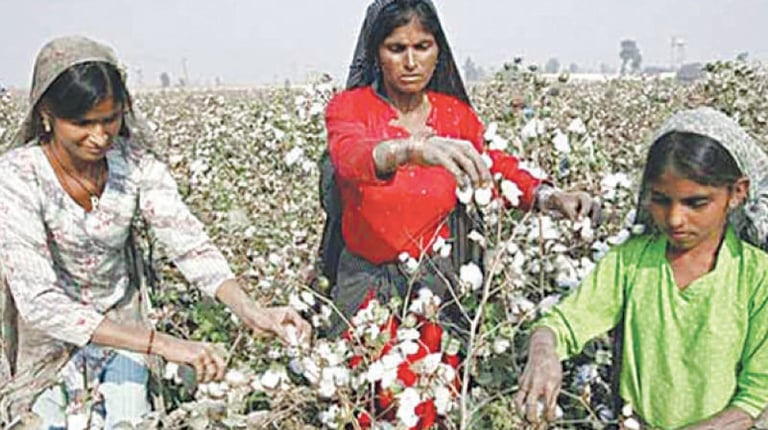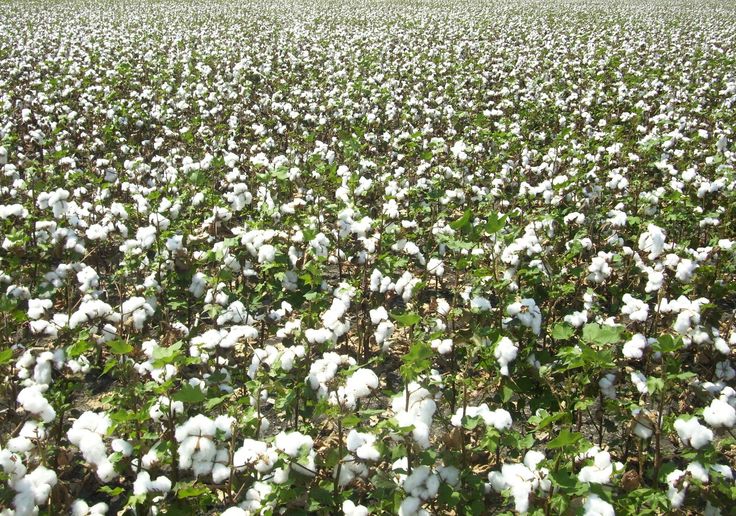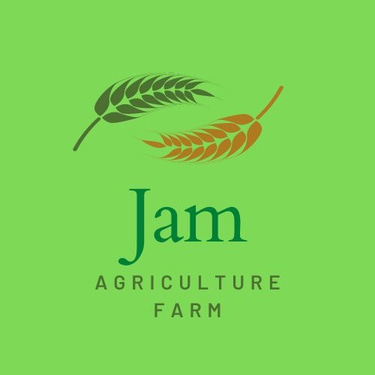Cotton Farming in Sindh, Pakistan
Cotton is the most important cash crop in Pakistan as well as in the world. It plays a leading role in the industrial and agricultural economy of the country. It provides raw materials to the textile industry.
AGRICULTURE
Cotton Farming
Cotton is the most important cash crop in Pakistan as well as in the world. It plays a leading role in the industrial and agricultural economy of the country. It provides raw materials to the textile industry. It provides direct livelihood to farmers and people employed in the cotton trade and its processing. Cotton is a water-desiring crop; around 6% of the water for irrigation is used for cultivation.
Archaeologists/historians believe that cotton existed 5000 years ago and Mohan-jo-Daro was a natural place of cotton, where the people knew the arts of spinning and weaving. Cotton lint was separated from seed on a charkha (a kind of hand-cranked roller gin) and the fibres were processed into fabrics with drop spindles and primitive looms. The quality of the textile produced has been excellent.
Cotton is a regular fiber that finds use in many products.se range from clothing to home furnishings to medical products. As a result, cotton is always in demand though its use is subject to the strengths and weaknesses of the overall economy. Pakistan is one of the earliest homes of cultivated cotton, the world’s 4th largest producer of cotton, the 3rd largest exporter of raw cotton and a leading exporter of yarn in the world. The value addition through cotton is 8.2 per cent in agriculture and 2 per cent in the GDP. A profound investment in the form of over 1,000 ginning factories, and over 400 textile mills heavily depends upon cotton.
Cotton is a major crop in Pakistan after wheat and it occupies the largest area in Pakistan compared to other crops. Cotton crop earns the country’s largest export revenues and in addition to the lint, the seed of cotton for oil and meal accounts for 80 per cent of the national production of oilseed. Cotton and cotton-related products contribute 10 per cent to the gross domestic product (GDP) and 55 per cent to the foreign exchange earnings of the country.
Selection of soil
The cotton can be grown on all types of soil having pH ranges in-between 6 and 8. Deep, friable, well-drained and fertile soil is good for crop cultivation. Sandy, saline or waterlogged soils are not suitable for cotton cultivation. The depth of soil should not be less than 20-25 cm.
Soil Preparation
It required thorough land preparation for good germination and growth of the crop. After removal of the Rabi crop, irrigate the field immediately then take ploughing of land. Carry out deep ploughing once in three years, it will help to keep a check on perennial weeds and also kill various soil-borne pests and diseases.
The optimum time for sowing is April–mid-May. For Management of Mealy-bug, sow Bajra, Arhar, Maize and Jowar in the fields surrounding the cotton crop. Avoid growing tur, moong and bhendi in and around the cotton field as these harbour insect pests. Cotton rotation with berseem and cluster bean is found to have a beneficial effect on the succeeding cotton crop.
Spacing
For BT cotton use a spacing of 75x15 cm under irrigated conditions while under rain-fed conditions use a spacing of 60x30 cm. For desi cotton use a spacing of 60x30 cm for rain-fed as well as for irrigated conditions.
Sowing method
Sowing should be done at depth of 5 cm. For sowing use a sowing drill for desi cotton while dibbling of seed is done in the case of hybrids and Bt cotton. Square planting is beneficial compared to rectangular planting. Few gaps arise due to failure of seed germination and mortality of seedlings. To overcome this gap filling is necessary. Two weeks after sowing the weak/diseased/damaged seedlings should be removed by keeping a healthy seedling/hill.
Cotton Seed Varieties and Seed Rate
FH-900, FH-901, FH-1000 & CIM-602 8-10 kg per acre
MNT-886, FH-142, BH-118 & CIM-473 8-10 kg per acre
Neelam-121, Chris-9, Reshmi & Harii 8-10 kg per acre
Dost, Shahbaz, Chris-134 & Chris 342 8-10 kg per acre
MNT-886, Chandii, Sohni, Nayab & NIA Ufaq 8-10 kg per acre
For Narri sowing method
FH-900, FH-901, FH-1000 & CIM-602 3-4 kg per acre
MNT-886, FH-142, BH-118 & CIM-473 3-4 kg per acre
Neelam-121, Chris-9, Reshmi & Harii 3-4 kg per acre
Dost, Shahbaz, Chris-134 & Chris 342 3-4 kg per acre
MNT-886, Chandii, Sohni, Nayab & NIA Ufaq 3-4 kg per acre
Seed Treatment
The seed of cotton is covered by short fibre. Before sowing removal of this is necessary as it will make it difficult for sowing. It can be removed by chemical and Non-chemical methods. In the Non-chemical method, seeds are soaked in water overnight, then next day rubbed with cow dung and wood ash or sawdust then dried in the shed before sowing. In the chemical method, Depending upon the fibres on the seeds, mix the 400 gm concentrated Sulphuric acid (Industrial grade) in 4 kg seeds for American cotton and 300 gm for 3 kg Desi cotton seed for 2-3 minutes. It will burn all the fibers of the seeds. Then fill 10 Ltr of water in the container, stir well and drain out the water. Wash the seeds for three times with normal water and then lime water (Sodium Bicarbonate@50gm/10Ltr of water) for 1 min. Give one more washing then dry the seeds in the shed. Do not use Metal or wood containers, instead use plastic or earthen pot and use plastic gloves by the operator for chemical method.
To protect from sucking pest attacks (up to 15-20 days) treat seeds with Imidacloprid (Confidor) 5-7ml or Thiamethoxam (CRUISER)@ 5-7gm/kg of seeds.
Fertilizer required (Kg/Acre)
Varieties Urea DAP or SSP MOP
BT Cotton 65 27 75 -
Desi 130 27 75 -
Weed Control
Due to wide-spaced crops, weeds pose a serious threat. A weed-free period of 50-60 days from sowing is necessary for good yield otherwise it may cause a 60-80% reduction in yields. Manual, mechanical and chemical methods of weed control in combination are necessary for effective weed control. Carry out first manual hoeing 5-6 weeks after sowing or before first irrigation. The remaining hoeing should be done after each irrigation. Do not allow congress grass to grow around cotton fields, as they increase the possibility of mealy bug infestation. To control weeds after sowing but before its emergence, take a spray of Pendimethalin @ 25-33 ml/10 Ltr of water. Apply Paraquat (Gramoxone) 24% WSC @ 500 ml/acre or Glyphosate @1 Ltr/acre in 100 Ltr of water, 6 to 8 weeks after sowing when the crop is 40-45 cm in height. The crop is highly sensitive to the 2,4-D weedicide. Its vapours can cause serious injury to cotton even if sprayed in adjoining fields. Spraying of herbicide should be carried out either in the morning hour or in the evening hours.
Irrigation
Recommended time for irrigation is given below in the table:-
Critical stages for Irrigation Interval
Branching and Square formation 45-50 days after sowing
Flowering and Fruiting stage 75-85 days after sowing
Boll formation 95-105 days after sowing
Boll development and boll opening 115-125 days after sowing
Cotton required four to six irrigation depending upon rainfall intensity. Give first Irrigation to the crop four to six weeks after sowing. And remaining irrigation at intervals of two or three weeks. Never let water stand in younger plants. Do not let the crop suffer for want of water during flowering and fruiting to avoid the shedding of flowers and bolls.
Give the last irrigation to the crop when 33% of bolls are opened and after that, there is no need for more water through irrigation. Whenever salty water has to use for irrigation, the water should be get tested by the authenticated laboratory and as per their recommendation, Gypsum or Pyrite may be added. In Drought Conditions, alternate furrow irrigation and the use of a micro irrigation system (wherever feasible) will be of immense help in saving irrigation water.
Cotton crop Diseases
Leaf Curl Virus: Upward and downward curling of leaves accompanied by small as well as main vein thickenings on leaves, pronounced on the underside. The newly produced leaves are small, excessively crinkled and curled at the edge. The primary stem often tends to grow taller than normal. The flowers squared in growth and become fruitless. Bolls remained small in size and failed to open. All parts of badly hit plants are very brittle and ready broken.
Boll Rot: The studies revealed that different types of symptoms may occur, which can be eminent on the basis of their specific causal agent as below:
Black boll or Aspergillus rot: bolls start losing green colour all in all, become pinkish brown and finally dusty black due to overgrowth of fungus.
Rhizopus rot: Diseased portions become greyish along with softening of internal tissues. The fungus grows profusely and covers many bolls under moist conditions.
Fusarium rot: The bolls become reddish and brownish tinge and show dry and white fluffy fungal on opening.
Bacterial or Xanthomonas rot: Water-soaking areas developed on the bolls giving out a gummy substance and foul smell.
Angular Leaf Spot or Bacterial Blight: The disease attacks all parts of the plant above ground level causing seedling rot, angular spots on leaves and stems, and boll rot.
Root Rot: This disease generally appears, when plants are about 4-6 weeks old and continue up to boll formation. Diseased plants can be easily pulled out of the soil, and appears in patches. Roots and root-lets show rotting, yellowing, disintegration and shredding.
Minor Diseases Anthracnose, leaf spots (caused by different fungi), sooty mold, stenosis, stunting and premature opening of bolls (Tirak) etc. are also reported to cause disease in cotton and damage to the crop, which may reduce the yield, sometimes very low and sometimes so much. Control Following disease management practices may help to save the crop from all the above major and minor diseases of cotton. Cultivation of disease-resistant variety is only a safe measure of all different diseases. Eradication including collection and burning of plant debris may help to control seedling, root and boll rots as well as bacterial blight, because disease inoculum may also survive through plant debris. Deep ploughing with a short duration, at least two months before sowing, help to control seedling and root rot.
Proper land levelling is a preventive measure against seedling and root rot. Use of healthy seed, acid delinting and chemical seed treatment minimize the disease incidence of seedling, root and boll rots as well as bacterial blight. · Crop rotation with non-host i.e. sowing of sorghum for 3 to 4 years is useful for control of seedling and root rot. Mixed cropping with kidney bean or fodder and leguminous crops save the cotton crop from root rot. Proper use of irrigation and chemical fertilizers improves the disease-resistant power in cotton plants. Early sowing of crop is a preventive measure for control of boll rot.
White fly transmits the cotton leaf curl virus from a diseased plant to a healthy one, whereas, different cotton bollworms may play a role to transmit the boll rot disease, hence white fly and bollworms must be controlled. Lady's finger (okra), sun kukri, china rose, thorn apple (dhatura), mint (podina), karund, cucurbits (especially watermelon), beans, tomatoes, tobacco, chillies, soybean, sunflower, cowpeas, eggplant (brinjal), hollyhock (gul-e-khera), zinnia, sesame, Ak (Calotropis), Sheesham, citrus species etc. are recorded as alternate host plants of cotton leaf curl virus as well as white fly, and also some of them is an alternate host of bollworms.
Therefore, they all must be eradicated before and during the cotton cropping season. Cotton growing zones may play a better role in this purpose. Meanwhile, the use of proper cotton production technology as per recommendations of agricultural experts/researchers is economical and most effective for cotton disease management. It is the outlook and responsibility of the cotton growers to adopt modern cotton production technology and play a role in the development and prosperity of the country.
Yield
With expectations for a slight increase in area, but stagnant yields, the 2022/23 production forecast is to reach 6.22 million bales, a 3.7 percent increase over 2021/22. Driven by Pakistan’s value-added cotton textile exports, cotton use is forecast to grow in 2022/23, at a modest 2 per cent.
Cotton growers from lower Sindh are getting a per-acre yield of fewer than 30 maunds as compared to 49 maunds in the not-too-distant past. Growers from upper Sindh are getting up to 55 maunds per acre.




